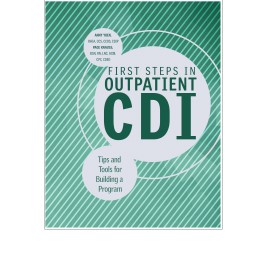Book excerpt: Strategies for obtaining medical staff support in the outpatient arena

Tips and Tools for Building a Program
By Anny Yuen, RHIA, CCS, CCDS, CDIP, and Page Knauss, BSN, RN, LNC, ACM, CPC, CDEO
The brevity of the patient encounter requires an organization’s outpatient CDI program to focus on improving documentation from the beginning. One of the goals for outpatient CDI should be to reduce denials due to lack of medical necessity. Another goal could be to make sure that the emergency department documentation is accurate and complete. In each of these encounters, the amount of time with the provider can be very limited. Face-to-face time with the patient could be as little as a few minutes. By designing an outpatient CDI program focused on improving documentation from the very first encounter, the CDI specialist has more opportunity for acquiring the documentation needed to support medical necessity or present-on-admission criteria.
Involve physicians in the design process
Physicians generally relate better to other physicians than they do to non-physicians. Therefore, the hospital should include physicians in the design process for all clinical documentation tools, especially electronic health record systems. Involve providers in the development of query templates and other tools, too. In the end, the provider will need to document in the chart and answer the queries, so they should be involved in the design process to ensure that the templates are easy to use.
Share public data
By regularly sharing publicly available data about hospitals and providers, such as rankings on HealthGrades.com, CDI teams can demonstrate the effect of documentation has on data. This practice may encourage providers to improve their own scores, and it can also be a wake-up call for physicians with particularly low scores.
Use metrics
Most hospitals have key metrics that are shared with the hospital management team and that CDI professionals can use to motivate providers. Key metrics may include monthly Ambulatory Payment Classification levels, volumes, and denials. Make a point to share metrics that are physician documentation–specific, such as query response rate. All metrics can be shared as one number, by specialty, or by physician group. Offer CMEs
Provide educational sessions to physicians on documentation and risk management that count toward their continuing education obligations. Organizations typically have a minimum number of CMEs that relate to documentation improvement. Encourage providers to take part in such sessions by clearly stating the session’s purpose and defining how it will help them improve their documentation processes. In addition, offering CMEs that are easy for the provider to obtain will make them more apt to participate in an educational session. For example, try using recorded webcasts or online learning, which allow physicians can set their own schedules and work around their other duties.
Editor’s note: This article is an excerpt from the book First Steps in Outpatient CDI: Tips and Tools for Building a Program.
